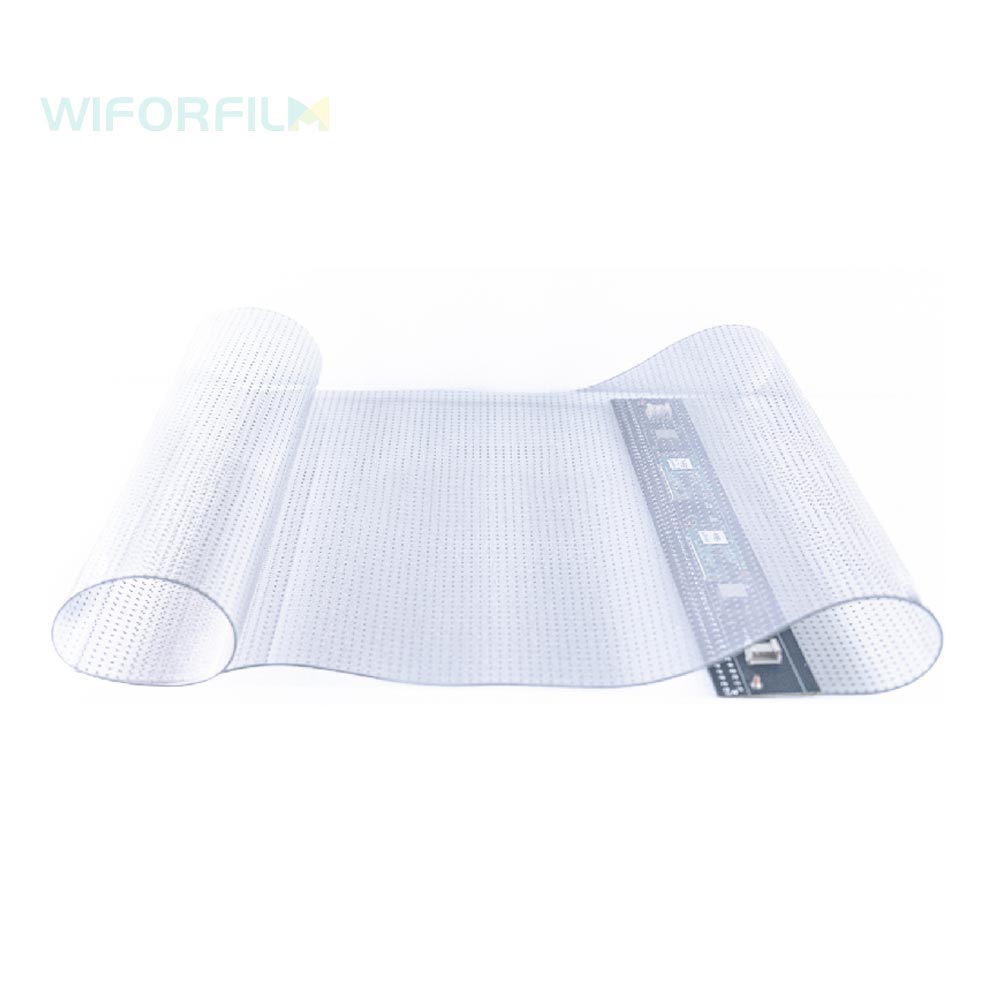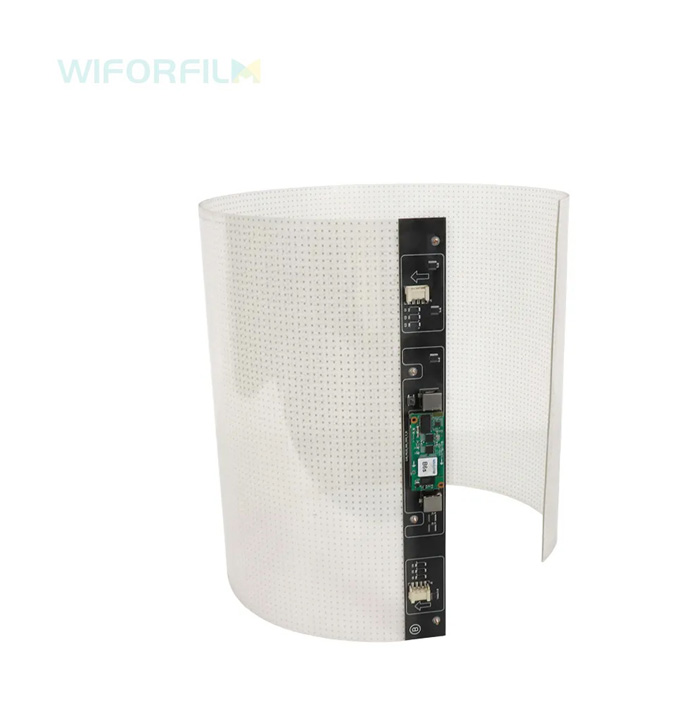2. How LED Film Displays Work
3. Key Benefits of Bendable LED Display
4. Applications of Bendable LED Display
5. Types of Bendable LED Displays
- 5.1.Flexible LED Film Displays
- 5.2.Flexible Transparent OLED Films
- 5.3.Full-color vs. Monochrome Displays
- 5.4.Outdoor vs. Indoor LED Film
7. Installation Process
8. Maintenance and Care
9. Performance Features: Brightness, Contrast, and Resolution
10. Energy Efficiency of LED Film Displays
11. Future Trends in Bendable Transparent LED Displays
12. Market Outlook
13. Cost
LED Film Displays – Overview
The technology is still relatively new and can be expensive compared to traditional displays.The prices of Transparent LED film displays vary according to different models, ranging from $650 to $2,200 per square meter.
The prices of holographic Transparent LED screen ranging from $1200 to $2,250 per square meter. LED film displays represent a significant leap in display technology, offering flexibility, transparency, and ease of integration. They are thin, bendable,rollable, and adhesive, making them suitable for a wide range of applications from retail windows to architectural installations. The key benefit of these displays is their ability to maintain high visibility, even in bright, transparent spaces like glass or ACRYLIC surfaces, allowing for both functionality and aesthetic appeal. LED film displays can be applied directly onto surfaces such as glass walls or windows and ACRYLIC, turning them into dynamic advertising screens or information displays without obstructing natural light.
What is a Bendable LED Display?
bendable led display is a flexible, ultra-thin layer of LEDs that can be adhered to various surfaces while still allowing light to pass through. These displays typically consist of micro-LEDs embedded into a transparent PU or PET substrate, which makes them suitable for installations where traditional displays would be impractical. The flexibility allows them to curve around surfaces, which is especially useful for architectural and interior design projects. The transparent nature of these films offers a unique visual experience as they don't block the view through the glass, making them ideal for modern advertising, design, and functional display applications.How LED Film Displays Work
Bendable led display work by embedding micro-LED chips onto a flexible, transparent substrate. These chips emit light when an electric current passes through them, and the light emitted can be controlled to display images, videos, or text. The adhesive backing allows these films to be installed on various surfaces, including windows, glass walls, and curved structures. Despite their thin and transparent nature, the brightness and resolution of LED film screen are often impressive, thanks to advanced technology in micro-LED production. The combination of transparency and flexibility opens up new possibilities for dynamic and unobtrusive displays.Key Benefits of Bendable LED Display
Applications of Bendable LED Display
They are commonly used in:
- Retail Advertising: Displaying dynamic advertisements on store windows, enabling high visibility without blocking the view of products.
- Architectural Installations: Creating interactive or decorative displays on buildings' glass facades.
- Public Spaces: Interactive displays in malls, airports, and public transit areas, providing information or advertisements.
- Transportation: Used in buses, trains, and subway windows to display schedules, advertisements, or interactive information.
- Event and Exhibition Displays: Interactive video walls or advertisements in trade shows, conventions, and exhibitions.
- Corporate Environments: Transparent displays for information sharing or branding in office spaces, lobbies, and meeting rooms.
Types of Bendable LED Displays
Design Considerations for Installations
When considering an LED film display, it's essential to account for several design factors:
- Surface Compatibility: Ensure the surface where the LED film will be applied is clean, smooth, and suitable for adhesion.
- Transparency Level: Determine the level of transparency needed for your application. While the film is inherently transparent, some variations offer higher transparency than others.
- Brightness and Viewing Distance: Consider the ambient lighting conditions and the distance at which viewers will be interacting with the display. Higher brightness might be needed for outdoor or high-traffic environments.
- Power Supply and Wiring: Since LED film displays require a power source, consider how to route power cables, especially for large or complex installations.
- Aesthetic Integration: The design should complement the surrounding architecture or space, ensuring the display doesn't detract from the overall aesthetic.
Installation Process
Installing a bendable transparent LED film is a relatively straightforward process, though it requires attention to detail. First, the surface must be thoroughly cleaned to remove any dust, dirt, or grease. The film is then carefully unrolled and positioned on the surface. Using the adhesive backing, the film can be gently pressed into place, with any air bubbles smoothed out. If needed, the film can be cut to fit specific dimensions or shapes. Lastly, the wiring is connected to a power source and a controller that will manage the display’s content. This installation can often be done without professional assistance, although larger or more complex setups may require specialized expertise.Maintenance and Care
One of the key advantages of LED film displays is their durability and low maintenance needs.
- Cleaning: Dust and dirt can be wiped away using a soft cloth and non-abrasive cleaning solutions. Avoid harsh chemicals or excessive moisture.
- Inspection: Periodically check for damaged pixels or areas where the adhesive may begin to loosen.
- Power Management: Ensure that the power supply is working correctly and check cables for signs of wear or damage.
- Environmental Considerations: Ensure the display is not exposed to excessive moisture, extreme temperatures, or other harsh environmental conditions that may affect its performance.
Performance Features: Brightness, Contrast, and Resolution
The performance of LED film displays is measured by several key factors:
- Brightness: Most transparent LED films offer brightness levels ranging from 2000 to 4000 nits, ensuring visibility even in well-lit environments.
- Contrast: High contrast ratios contribute to the clarity of text and images displayed, especially in environments with ambient light.
- Resolution: While LED films typically have lower resolution than standard LED screens, advancements in micro-LED technology have made it possible to achieve high-quality displays with crisp visuals, even at relatively close viewing distances.
Energy Efficiency of LED Film Displays
The LED film displays unlike traditional cathode-ray tube (CRT) or even some LCD displays, LED technology uses far less power. Average power:200w/㎡, For large-scale installations or outdoor use, this energy efficiency translates into substantial savings over time.Future Trends in Bendable Transparent LED Displays
The future of LED film displays is likely to be shaped by several key trends:
- Higher Transparency: Continued advancements in transparency will further improve the seamless integration of LED films into architectural designs.
- Enhanced Flexibility: Future films may offer even greater flexibility, allowing them to conform to more intricate shapes or surfaces.
- Higher Resolution and Color Accuracy: As micro-LED technology advances, displays will likely achieve higher resolutions and better color reproduction.
- Smarter Integration: Integration with smart technologies like IoT (Internet of Things) could allow for more interactive and responsive displays.
- Sustainability: Efforts to reduce the environmental impact of production processes and increase energy efficiency will shape the industry’s future direction.
Market Outlook
The market for bendable transparent LED film displays is expected to grow rapidly in the coming years. As more businesses and architects see the potential for innovative displays in retail, advertising, and architecture, demand for flexible, transparent displays will continue to rise. The adoption of these technologies in sectors like entertainment, smart buildings, and transportation will also fuel market growth. With ongoing improvements in technology, pricing, and functionality, transparent LED films are likely to become a standard solution for dynamic and interactive displays.Cost
The technology is still relatively new and can be expensive compared to traditional displays.The prices of Transparent LED film displays vary according to different models, ranging from $650 to $2,200 per square meter.
The prices of holographic Transparent LED screen ranging from $1200 to $2,250 per square meter.










